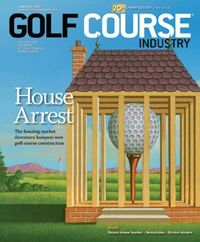Q What cultural practices did golf course superintendent John Zimmers implement at Oakmont Country Club this past June to reach firm greens, and how long did the process take?
A The USGA maintains U.S. Open Championship putting surfaces firm and fast. Because the club has 100-year-old-soil greens, the draining capacity required improvement and firming for daily play and championship guidelines. Immediately after Zimmers arrived at Oakmont, he began a five-year, subsurface soil modification program. This process, which is ongoing at Oakmont, includes:
1. A deep drill-and-fill process for all greens. The holes created are back-filled with sand.
2. Deep-tine aerification with three-quarter-inch solid tines.
3. Standard hollow coring using pedestrian aerifying units. All cores were removed and holes were filled with sand topdressing, which was hand brushed into all holes.
4. Sand injection using the DryJect units that produced aerification holes in the root zone and filled them with the sand material.
5. After coring, green surfaces were verticut with a less aggressive unit using the smallest width cutting blades to reduce the impact to mounding and surface contours and avoid scalping.
6. To move water down further and away from the surface, Zimmers hired a contractor to install the subsurface drain lines to pick up all water before it reached the low points of each green. For those who watched the U.S. Open, the nongreen lines visible on the surface were the subsurface drain lines.
Q What steps did Russ Myers, CGCS, take to reduce the heat stress to the putting surfaces as he prepared Southern Hills Country Club for the PGA Championship?
A Southern Hills is situated in a “pocket” with trees surrounding many of the putting surfaces throughout the golf course. Of course a critical element contributing to healthy putting greens in the heat and humidity typical of Tulsa is proper air movement across each surface. Myers had less than a year to remedy the issue. While the club agreed to remove a certain number of trees, there still was a need for increased air movement. Additionally, Tulsa experienced its wettest season in many years. The solution was to install large fans for air circulation. However, the challenge was to provide power to operate the large fans. Myers resolved the issue by following this process:
- First, he initiated a limited tree-removal program near greens that had the poorest growing environments.
- Next, he researched the costs to install power and wiring. Evaluation of equipment, boring, wiring, labor and scheduling costs was six figures.
- Following this thorough investigation, Myers decided Southern Hills should purchase the boring equipment. He mapped a route, contracted an electrician, positioned the fans based on a sunlight/shade impact study. And for championship requirements, he provided mobile fan units to be removed during play and repositioned each night, if necessary, to avoid any Rules of Golf concerns.
- Since the greens are built to USGA guidelines, he installed subsurface air conditioning to aid venting air through the subprofile.
- Finally, Myers increased his aerification program to reduce and modify the organic matter build up and increase gaseous exchange within the putting green profile.
Q At the 2006 U.S. Open Championship at Winged Foot Golf Club, the USGA instituted its successful graduated rough concept to balance the penalty for missing the fairway. Even at a lower height of cut, the primary rough still produced a stiff penalty. What was superintendent Eric Greytok’s program for rough renovation?
A A thorough tree survey was conducted for the entire property, evaluating the short- and long-term health of the trees, as well as the planned rough renovation. With membership approval, all dangerous, diseased, damaged, selective evergreen and nonindigenous species were removed gradually to produce a better growing climate.
Championship fairway and rough contour lines were established to serve as a guide for Greytok. The fairway turf to be converted to rough was stripped, removed and resodded to match the upcoming rough turf selection. The plan included a siding process, as well as an overseeding program.
Surface preparation began, starting with a proper nutrient plan, drainage installation and additional irrigation (drainage and irrigation was difficult because of the rock ledge under the turfgrass) for the overseed to establish.
Multiple overseeding, using perennial ryegrass and Kentucky bluegrass, was conducted in the fall and the spring of each year leading up to 2006, beginning in 2003.
The 2004 U.S. Amateur served as an evaluation to review fairway and rough contour lines, which would be modified further for the 2006 U.S. Open. All changes were finalized by fall 2005.
Mowing widths and heights of cut were established by the USGA in the fall 2005 and tweaked slightly in spring 2006.
Entering the U.S. Open, the rough was healthy, thick and ready. The first pass of graduated rough was mowed each day at three inches, the next step at six inches, and beyond that, the rough was not cut for the entire championship. GCI
Tim Moraghan is principal of Aspire Golf Consulting in Long Valley, N.J. He can be reached at tmoraghan11@comcast.net or 908-636-7978.
Editor’s note: If you have questions about course set-up or maintenance related to golf tournaments or events, e-mail Tim Moraghan.

Explore the January 2008 Issue
Check out more from this issue and find your next story to read.
Latest from Golf Course Industry
- Golf Construction Conversations: Stephen Hope
- EnP welcomes new sales manager
- DLF opening centers in Oregon, Ontario
- Buffalo Turbine unveils battery-powered debris blower
- Beyond the Page 66: Keep looking up
- SePRO hires new technical specialist
- Plant Fitness adds Florida partner
- LOKSAND opens North American office





